Oceanography: waves
| When the wind blows across the water, it
changes the water's surface, first into ripples and then into waves.
Storms can make enormous waves, particularly if the wind, blows in the
same direction for any length of time. In this chapter, you can learn
what waves are and how they behave. |
|
|
|
Waves have a major influence on the marine environment and ultimately
on the planet's climate. |
|
|
|
Waves travel effortlessly along the water's surface. This is made
possible by small movements of the water molecules. This chapter looks
at how the motion is brought about and how waves can change speed,
frequency and depth. |
|
|
|
The wind blows over the water, changing its surface into ripples and
waves. As waves grow in height, the wind pushes them along faster and
higher. Waves can become unexpectedly strong and destructive. |
|
|
|
As waves enter shallow water, they become taller and slow down,
eventually breaking on the shore. |
|
|
|
In the real world, waves are not of an idealised, harmonious shape but
irregular. They are composed of several interfering waves of different
frequency and speed. |
|
|
|
Water waves bounce off denser objects such as sandy or rocky shores.
Very long waves such as tsunamis bounce off the continental slope. |
|
|
|
Tsunamis are caused by deep earthquakes which disturb the water above
them, causing a wave front to radiate out at high speed. Tsunamis are
unpredictable and can cause considerable damage. Mega
tsunamis may occur when asteroids hit the ocean or when volcanoes
erupt. |
|
|
|
Seiches are standing waves in lakes, harbours and enclosed oceans.
Bores are rapidly moving waves, caused by spring tides entering
narrowing rivers. |
|
|
|
Internal waves are an interesting phenomenon that cannot be observed
from above. They propagate along layers caused by thermoclines,
underlying fresh water and the like. They can cause sizeable undersea
waves. |
|
|
|
Waves cause damage to the coast. Whereas healthy dunes
and beaches are able to repair themselves, the rocky shore is not.
This section looks at how waves cause damage to the rocky shore. |
--home--index--previous
chapter--next
chapter--Rev 20000420,20000511,20010225,20010428,
Waves in the environment
Without waves, the world would be a different place. Waves cannot exist
by themselves for they are caused by winds. Winds in turn are caused by
differences in temperature on the planet, mainly between the hot tropics
and the cold poles.
Without waves, the winds would have only a very small grip on the water
and would not be able to move it as much. The waves allow the wind to
transfer its energy to the water's surface and to make it move. At the
surface, waves promote the exchange of gases: carbon dioxide into the
oceans and oxygen out. Currents and eddies mix the layers of water which
would otherwise become stagnant and less conducive to life. Nutrients
are thus circulated and re-used. |
The large ocean currents transport warm water from the tropics to the poles and
cold water the other way. They help to stabilise the planet's temperature and to
minimise its extremes. For instance, because of warm ocean currents arriving
from the north, the temperature of New Zealand is 3-4 degrees higher than it
would be without them.
For the creatures in the sea, ocean currents allow their larvae to be
dispersed and to be carried great distances. Many creatures spawn only during
storms when large waves can mix their gametes effectively.
Coastal creatures living in shallow water experience the brunt of the waves
directly. In order to survive there, they need to be robust and adaptable. Thus
waves maintain a gradient of bio-diversity all the way from the surface, down to
depths of 30m or more. Without waves, there would not be as many species living
in the sea.
Waves pound rocks and make them erode faster, but sea organisms covering
these rocks, delay this process. Waves make beaches by transporting sand from
deeper down towards the shore and by washing the sand and removing fine
particles. Waves stir and suspend the sand so that currents or gravity can
transport it.
Wave motion
Anyone having watched water waves rippling outward from the point where
a stone was thrown in, should have noticed how effortlessly waves can
propagate along the water's surface. Wherever we see water, we see its
surface stirred by waves. Indeed, witnessing a lake or sea flat like a
mirror, is rather unusual. Yet, as familiar we are with waves, we are
unfamiliar with how water particles can join forces to make such waves. |
Waves are oscillations in the water's surface. For oscillations to exist and
to propagate, like the vibrating of a guitar string or the standing waves in a
flute, there must be a returning force that brings equilibrium. The tension in a
string and the pressure of the air are such forces. Without these, neither the
string nor the flute could produce tones. The standing waves in musical
instruments bounce their energy back and forth inside the string or the flute's
cavity. The oscillations that are passed to the air are different in that they
travel in widening spheres outward. These travelling waves have a direction and
speed in addition to their tone or timbre. In air their returning force is the
compression of the air molecules. In surface waves, the returning force is
gravity, the pull of the Earth. Hence the name 'gravity waves' for water waves.
In solids, the molecules are tightly connected together, which prevents them
from moving freely, but they can vibrate. Water is a liquid and its molecules
are allowed to move freely although they are placed closely together. In gases,
the molecules are surrounded by vast expanses of vacuum space, which allows them
to move freely and at high speed. In all these media, waves are propagated by
compression of the medium. However, the surface waves between two media (water
and air), behave very different and solely under the influence of gravity, which
is much weaker than that of elastic compression, the method by which sound
propagates.
The specific volume of
sea water changes by only about 4 thousands of 1 percent (4E-5) under a
pressure change of one atmosphere (1 kg/cm2).
This may seem insignificant, but the Pacific Ocean would stand about 50m
higher, except for compression of the water by virtue of its own weight,
or about 22cm higher in the absence of the atmosphere. Since an
atmosphere is about equal to a column of water 10m high, the force of
gravity is about 43 times weaker than that of elastic compression.
Surface tension (which forms droplets) exerts a stress
parallel to the surface, equivalent to only one 74 millionth (1.4E-8) of
an atmosphere. Its restoring force depends on the curvature of the
surface and is still smaller. Nevertheless it dominates the behaviour of
small ripples (capillary waves), whose presence greatly contributes to
the roughness (aerodynamic drag) of the sea surface, and hence, to the
efficiency with which can generate larger waves and currents. (Van
Dorn, 1974) |
If each water particle makes small oscillations around its spot, relative to
its neighbours, waves can form if all water particles move at the same time and
in directions that add up to the wave's shape and direction. Because water has a
vast number of molecules, the height of waves is theoretically unlimited. In
practice, surface waves can be sustained as high as 70% of the water's depth or
some 3000m in a 4000m deep sea (Van Dorn, 1974).
Note that the water particles do not travel but only their collective energy
does! Waves that travel far and fast, undulate slowly, requiring the water
particles to make slow oscillations, which reduces friction and loss of energy.
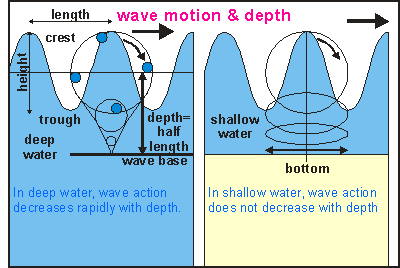 In
the diagram some familiar terms are shown. A floating object is observed to move
in perfect circles when waves oscillate harmoniously sinus-like. If that object
hovered in the water, like a water particle, it would be moving along
diminishing circles, when placed deeper in the water. At a certain depth, the
object would stand still. This is the wave's base, precisely half the wave's
length. Thus long waves (ocean swell) extend much deeper down than short waves
(chop). Waves with 100 metres between crests are common and could stir the
bottom down to a depth of 50m. Note that the depth of a wave has little to do
with its height! But a wave's height contains the wave's energy, which is
unrelated to the wave's length. Long surface waves travel faster and further
than short ones.
In
the diagram some familiar terms are shown. A floating object is observed to move
in perfect circles when waves oscillate harmoniously sinus-like. If that object
hovered in the water, like a water particle, it would be moving along
diminishing circles, when placed deeper in the water. At a certain depth, the
object would stand still. This is the wave's base, precisely half the wave's
length. Thus long waves (ocean swell) extend much deeper down than short waves
(chop). Waves with 100 metres between crests are common and could stir the
bottom down to a depth of 50m. Note that the depth of a wave has little to do
with its height! But a wave's height contains the wave's energy, which is
unrelated to the wave's length. Long surface waves travel faster and further
than short ones.
Water waves can store or dissipate much energy. Like other waves (alternating
electric currents, e.g.), a wave's energy is proportional to the square of its
height (potential). Thus a 3m high wave has 3x3=9 times more energy than a 1m
high wave. When fine-weather waves of about 1m height pound on the beach, they
dissipate an average of 10kW (ten one-bar heaters) per metre of beach or the
power of a small car at full throttle, every five metres. (Ref Douglas
L Inman in Oceanography, the last frontier, 1974). Attempts to harness the
energy from waves have failed because they require large structures over large
areas and these structures should be capable of surviving storm conditions with
energies hundreds of times larger than they were designed to capture.
Waves have a direction and speed. Sound waves propagate by compressing the
medium. They can travel in water about 4.5 times faster than in air, about 1500m
per second (5400km/s, or mach-4.5, depending on temperature and salinity). Such
waves can travel in all directions and reach the bottom of the ocean (about 4km)
in less than a second. Surface waves, however, are limited by the density of
water and the pull of gravity. They can travel only along the surface and their
wave lengths can at most be about twice the average depth of the ocean (2 x 4
km). The fastest surface waves observed, are those caused by tsunamis. The
'tidal wave' caused by an under-sea earthquake in Chile in May 1960, covered the
6000 nautical miles (11,000km) to New Zealand in about 12 hours, travelling at a
speed of about 900 km/hr! When it arrived, it caused an oscillation in
water level of 0.6m at various places along the coast, 1.4m in Tauranga Harbour
and 2.4m in Whitianga harbour. Note that tsunamis reach their minimum at about
6000 km distance. Beyond that, coriolis forces bend the wave fronts to focus
them again at a distance of about 12,000 km, where they can still cause
considerable damage.
The relationship between
wave speed (phase velocity) and depth of long surface waves in shallow
water is given by the formula
c x c = g x d x (p2
- p1) / p2 or
c x c= g x d
for water/air
where c= wave speed, g= acceleration of
gravity (9.8066 m/s/s), d= wave depth (or upper layer depth,
m), p2= density of water (=1) and p1= density of air (=
0.00125).
The formula states that wave speed increases with wave
depth and the relative difference in density.
For an ocean depth of 4000m, a wave's celerity or speed
would be about SQR(10 x 4000) = 200 m/s = 720 km/hr. Surface waves could
theoretically travel much faster on larger planets, in media denser than
water.
For deep water, the relationship between speed and
wavelength is given by the formula:
l = g x t x t / (2 x pi)
l = t x c for all kinds of
waves, substitute in above equation: t x c = g x t x t / (2 x pi)
c = g x t / (2 x pi)
or t = c x 2 x pi / g or t = c x 0.641 (s)
where t= wave period (sec), f= wave
frequency, l= wave length (m) and pi=3.1415...
to calculate c and l from wave period t
(in sec): c = t x 1.56 m/s= t x 5.62 km/hr
= t x 3.0 knot
l = 1.56 x t x t (metres)
Thus waves with a period of 10 seconds, travel at 56
km/hr with a wave length of about 156m. A 60 knot (110 km/hr) gale can
produce in 24 hours waves with periods of 17 seconds and wave lengths of
450m. Such waves travel close to the wind's speed (97 km/hr). A tsunami
travelling at 200 m/s has a wave period of 128 s, and a wave length of
25,600 m. |
 These
two diagrams show the relationships between wave speed and period for
various depths (left), and wave length and period (right), for periodic,
progressive surface waves. (Adapted from Van Dorn, 1974)
Note that the term phase velocity is more precise than wave
speed. These
two diagrams show the relationships between wave speed and period for
various depths (left), and wave length and period (right), for periodic,
progressive surface waves. (Adapted from Van Dorn, 1974)
Note that the term phase velocity is more precise than wave
speed.
The period of waves is easy to measure using a
stopwatch, whereas wave length and speed are not. In the left picture,
the red line gives the linear relationship between wave speed and wave
period. A 12 second swell in deep water travels at about 20m/s or 72
km/hr. From the red line in the right diagram, we can see that such
swell has a wave length between crests of about 250m.
When the 12s swell enters 10m shallow water (follow the
green curve for 10m), its speed will halve to 10m/s (left graph) and so
will its wave length (right graph). But the height of the wave increases
by a similar factor (not shown here).
|
Waves and wind
 How
wind causes water to form waves is easy to understand although many
intricate details still lack a satisfactory theory. On a perfectly calm
sea, the wind has practically no grip. As it slides over the water
surface film, it makes it move. As the water moves, it forms eddies and
small ripples. Ironically, these ripples do not travel exactly in the
direction of the wind but as two sets of parallel ripples, at angles
70-80º to the wind direction. The ripples make the water's surface
rough, giving the wind a better grip. The ripples, starting at a minimum
wave speed of 0.23 m/s, grow to wavelets and start to travel in the
direction of the wind. At wind speeds of 4-6 knots (7-11 km/hr), these
double wave fronts travel at about 30º from the wind. The surface still
looks glassy overall but as the wind speed increases, the wavelets
become high enough to interact with the air flow and the surface starts
to look rough. The wind becomes turbulent just above the surface and
starts transferring energy to the waves. Strong winds are more turbulent
and make waves more easily. How
wind causes water to form waves is easy to understand although many
intricate details still lack a satisfactory theory. On a perfectly calm
sea, the wind has practically no grip. As it slides over the water
surface film, it makes it move. As the water moves, it forms eddies and
small ripples. Ironically, these ripples do not travel exactly in the
direction of the wind but as two sets of parallel ripples, at angles
70-80º to the wind direction. The ripples make the water's surface
rough, giving the wind a better grip. The ripples, starting at a minimum
wave speed of 0.23 m/s, grow to wavelets and start to travel in the
direction of the wind. At wind speeds of 4-6 knots (7-11 km/hr), these
double wave fronts travel at about 30º from the wind. The surface still
looks glassy overall but as the wind speed increases, the wavelets
become high enough to interact with the air flow and the surface starts
to look rough. The wind becomes turbulent just above the surface and
starts transferring energy to the waves. Strong winds are more turbulent
and make waves more easily. |
The rougher the water becomes, the easier it is for the
wind to transfer its energy. The waves become steep and choppy. Further away
from the shore, the water's surface is not only stirred by the wind but also by
waves arriving with the wind. These waves influence the motion of the water
particles such that opposing movements gradually cancel out, whereas
synchronising movements are enhanced. The waves start to become more rounded and
harmonious. Depending on duration and distance (fetch), the
waves develop into a fully developed sea.
Anyone familiar with the sea, knows that waves never assume a uniform,
harmonious shape. Even when the wind has blown strictly from one direction only,
the resulting water movement is made up of various waves, each with a different
speed and height. Although some waves are small, most waves have a certain
height and sometimes a wave occurs which is much higher.
 When
trying to be more precise about waves, difficulties arise: how do we
measure waves objectively? When is a wave a wave and should be counted?
Scientists do this by introducing a value E which is derived from
the energy component of the compound wave. In the left part of the
drawing is shown how the value E is derived entirely
mathematically from the shape of the wave. Instruments can also measure
it precisely and objectively. The wave height is now proportional to the
square root of E. When
trying to be more precise about waves, difficulties arise: how do we
measure waves objectively? When is a wave a wave and should be counted?
Scientists do this by introducing a value E which is derived from
the energy component of the compound wave. In the left part of the
drawing is shown how the value E is derived entirely
mathematically from the shape of the wave. Instruments can also measure
it precisely and objectively. The wave height is now proportional to the
square root of E.
The sea state E is two times the average of the
sum of the squared amplitudes of all wave samples.
The right part of the diagram illustrates the
probability of waves exceeding a certain height. The vertical axis
gives height relative to the square root of the average energy state of
the sea: h / SQR( E ) . For understanding the graph, one
can take the average wave height at 50% probability as reference.
Fifty percent of all waves exceed the average wave
height, and an equal number are smaller. The highest one-tenth of all
waves are twice as high as the average wave height (and four times more
powerful). Towards the left, the probability curve keeps rising off the
scale: one in 5000 waves is three times higher and so on. The
significant wave height H3 is twice the most probable height and occurs
about 15% or once in seven waves, hence the saying "Every seventh
wave is highest".
|
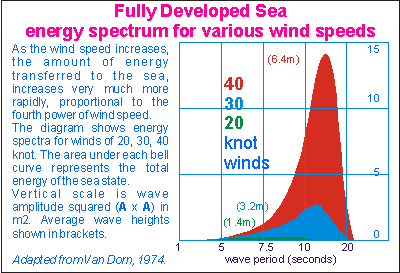 When
the wind blows sufficiently long from the same direction, the waves it
creates, reach maximum size, speed and period beyond a certain distance
(fetch) from the shore. This is called a fully developed sea.
Because the waves travel at speeds close to that of the wind, the wind
is no longer able to transfer energy to them and the sea state has
reached its maximum. In the picture the wave spectra of three different
fully developed seas are shown. The bell curve for a 20 knot wind
(green) is flat and low and has many high frequency components (wave
periods 1-10 seconds). As the wind speed increases, the wave spectrum
grows rapidly while also expanding to the low frequencies (to the
right). Note how the bell curve rapidly cuts off for long wave periods,
to the right. Compare the size of the red bell, produced by 40 knot
winds, with that of the green bell, produced by winds of half that
speed. The energy in the red bell is 16 times larger! When
the wind blows sufficiently long from the same direction, the waves it
creates, reach maximum size, speed and period beyond a certain distance
(fetch) from the shore. This is called a fully developed sea.
Because the waves travel at speeds close to that of the wind, the wind
is no longer able to transfer energy to them and the sea state has
reached its maximum. In the picture the wave spectra of three different
fully developed seas are shown. The bell curve for a 20 knot wind
(green) is flat and low and has many high frequency components (wave
periods 1-10 seconds). As the wind speed increases, the wave spectrum
grows rapidly while also expanding to the low frequencies (to the
right). Note how the bell curve rapidly cuts off for long wave periods,
to the right. Compare the size of the red bell, produced by 40 knot
winds, with that of the green bell, produced by winds of half that
speed. The energy in the red bell is 16 times larger!
Important to remember is that the energy of the sea
(maximum sea condition) increases very rapidly with wind speed,
proportional to its fourth power. The amplitude of the waves increases
to the third power of wind speed. This property makes storms so
unexpectedly destructive. |
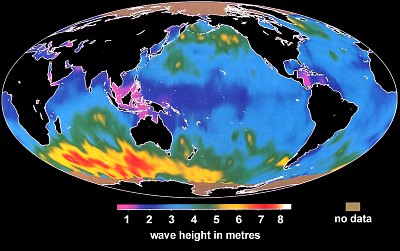 The
biggest waves on the planet are found where strong winds consistently
blow in a constant direction. Such a place is found south of the Indian
Ocean, at latitudes of -40º to -60º, as shown by the yellow and red
colours on this satellite map. Waves here average 7m, with the
occasional waves twice that height! Directly south of New Zealand, wave
heights exceeding 5m are also normal. The lowest waves occur where wind
speeds are lowest, around the equator, particularly where the wind's
fetch is limited by islands, indicated by the pink colour on this map.
However, in these places, the sea water warms up, causing the birth of
tropical cyclones, typhoons or hurricanes, which may send large waves in
all directions, particularly in the direction they are travelling. The
biggest waves on the planet are found where strong winds consistently
blow in a constant direction. Such a place is found south of the Indian
Ocean, at latitudes of -40º to -60º, as shown by the yellow and red
colours on this satellite map. Waves here average 7m, with the
occasional waves twice that height! Directly south of New Zealand, wave
heights exceeding 5m are also normal. The lowest waves occur where wind
speeds are lowest, around the equator, particularly where the wind's
fetch is limited by islands, indicated by the pink colour on this map.
However, in these places, the sea water warms up, causing the birth of
tropical cyclones, typhoons or hurricanes, which may send large waves in
all directions, particularly in the direction they are travelling. |
Waves entering shallow water
 As
waves enter shallow water, they slow down, grow taller and change shape.
At a depth of half its wave length, the rounded waves start to rise and
their crests become shorter while their troughs lengthen. Although their
period (frequency) stays the same, the waves slow down and their overall
wave length shortens. The 'bumps' gradually steepen and finally break in
the surf when depth becomes less than 1.3 times their height. Note that
waves change shape in depths depending on their wave length, but
break in shallows relating to their height! As
waves enter shallow water, they slow down, grow taller and change shape.
At a depth of half its wave length, the rounded waves start to rise and
their crests become shorter while their troughs lengthen. Although their
period (frequency) stays the same, the waves slow down and their overall
wave length shortens. The 'bumps' gradually steepen and finally break in
the surf when depth becomes less than 1.3 times their height. Note that
waves change shape in depths depending on their wave length, but
break in shallows relating to their height!
How high a wave will rise, depends on its wave length (period) and
the beach slope. It has been observed that a swell of 6-7m height in
open sea, with a period of 21 seconds, rose to 16m height off Manihiki
Atoll, Cooks Islands, on 2 June, 1967. Such swell could have arisen from
a 60 knot storm.
|
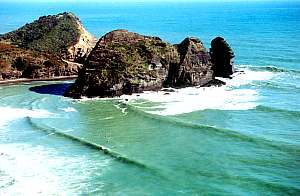 |
The photo shows waves entering shallow water at Piha,
New Zealand. Notice how the wave crests rise from an almost invisible
swell in the far distance. As they enter shallow water, they also change
shape and are no longer sinus-like. Although their period remain the
same, their distance between crests and their speed, diminish.
Not quite visible on this scale are the many surfies
in the water near the centre of the picture. They favour this spot
because as the waves bend around the rocks, and gradually break in a
'peeling' motion, they can ride them almost all the way back to the
beach.
|
Going back to the 'wave motion
and depth' diagram showing how water particles move, we can see that all
particles make a circular movement in the same direction. They move up on the
wave's leading edge, forward on its crest, down on its trailing slope and
backward on its trough. In shallow water, the particles close to the bottom will
be restricted in their up and downward movements and move along the bottom
instead. As the diagram shows, the particle's amplitude of movement does not
decrease with depth. The forward/backward movement over the sand creates ripples
and disturbs it.
Since shallow long waves have short crests and long troughs, the sand's forward
movement is much more brisk than its backward movement, resulting in sand being
dragged towards the shore. This is important for sandy beaches.
| Note that a sandy bottom is just another medium,
potentially capable of guiding gravity waves. It is about 1.8 times
denser than water and contains about 30-40% liquid. Yet, neither does it
behave like a liquid, nor entirely like a solid. It resists downward and
sideways movements but upward movements not as much. So waves cannot
propagate over the sand's surface, like they do along the water's
surface, but divers can observe the sand 'jumping up' on the leading
edge of a wave crest passing overhead (when the water particles move
upward). This may help explain why sand is so easily stirred up by waves
and why burrowing organisms are washed up so readily. |
Surf breakers are classified in three types:
- Spilling breakers: result from waves of low steepness (long period
swell) over gentle slopes. They cause rows of breakers, rolling towards the
beach. Such breakers gradually transport water towards the beach during
groups of high waves. Rips running back to sea, transport this water away
from the beach during groups of low waves. When caught swimming in a rip, do
not attempt to swim back to shore because such rips can be very strong (up
to 8 km/hr). Swim parallel to the beach towards where the waves are highest.
This is where water moves towards the beach. The next group of tall
waves should assist you to swim back to shore. However, when launching
(rescue) boats, this is best done in a rip zone.
- Plunging breakers: result from steeper waves over moderate slopes.
The slope of a beach is not constant but may change with the tide. Some
beaches are steep toward high tide, others toward low tide. A plunging
breaker is dangerous for swimmers because its intensity is greatly augmented
by backwash from its predecessor. This strong backwash precludes easy exit
from the breaker zone, particularly for divers. Often a steep bank of loose
sand prevents one from standing upright. In order to exit safely, wait for a
group of low waves.
- Surging breakers: occur where the beach slope exceeds wave
steepness. The wave does not really curl and break but runs up against the
shore while producing foam and large surges of water. Such places are
dangerous for swimmers because the rapidly moving water can drag swimmers
over the rocks.
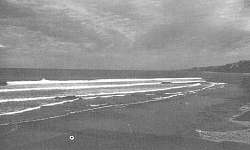
Spilling breakers are a familiar sight on most beaches.
They arise from long waves breaking on gently sloping beaches. There are
several rows of breakers. |

Plunging breakers can occur on steeply sloping beaches.
There is only one row of breakers. |
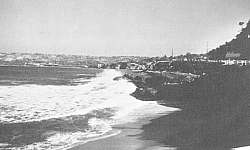
Surging breakers surge over steeply sloping (but not
vertical) beaches or rocks. Waves break one at a time.
Photos Van Dorn, 1974 |
When waves break, their energy is absorbed and converted to heat. The gentler
the slope of the beach, the more energy is converted. Steep slopes such as rocky
shores do not break waves as much but reflect them back to sea.
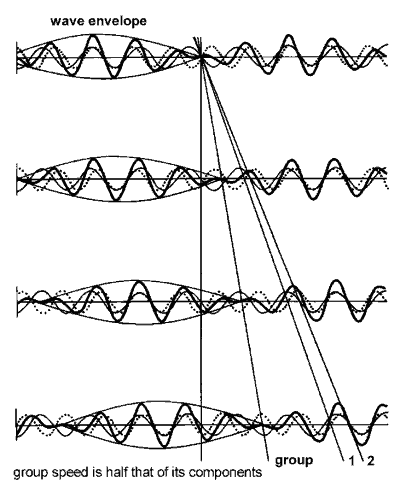 Wave
groups Wave
groups
Part of the irregularity of waves can be explained by treating them as
formed by interference between two or more wave trains of different
periods, moving in the same direction. It explains why waves often occur
in groups. The diagram shows how two wave trains (dots and thin line)
interfere, producing a wave group of larger amplitude (thick line). Such
a wave group moves at half the average speed of its component waves. The
wave's energy spectrum, discussed earlier, does not move at the speed of
the waves but at the group speed. When distant storms send long waves
out over great distances, they arrive at a time that corresponds with
the group speed, not the wave speed. Thus a group of waves, with a
period of 14s would travel at a group velocity of 11m/s (not 22 m/s) and
take about 24 hours (not 12 hr) to reach the shore from a cyclone 1000
km distant. A group of waves with half the period (7s) would take twice
as long, and would arrive a day later. (Harris, 1985)
Most wave systems at sea are comprised of not just two, but many
component wave trains, having generally different amplitudes as well as
periods. This does not alter the group concept, but has the effect of
making the groups (and the waves within them) more irregular.
Anyone having observed waves arriving at a beach will have noticed
that they are loosely grouped in periods of high waves, alternated by
periods of low waves.
Adapted from Van Dorn, 1974.
|
Wave reflection
Like sound waves, surface waves can be bent (refracted) or bounced back
(reflected) by solid objects. Waves do not propagate in a strict line
but tend to spread outward while becoming smaller. Where a wave front is
large, such spreading cancels out and the parallel wave fronts are seen
travelling in the same direction. Where a lee shore exists, such as
inside a harbour or behind an island, waves can be seen to bend towards
where no waves are. In the lee of islands, waves can create an area
where they interfere, causing steep and hazardous seas. |
When approaching a gently sloping shore, waves are slowed down and bent
towards the shore.
When approaching a steep rocky shore, waves are bounced back, creating a
'confused sea' of interfering waves with twice the height and steepness. Such
places may become hazardous to shipping in otherwise acceptable sea conditions.
 When
wave fronts approach a gently sloping beach on an angle, they slow down
in the shallows, causing them to bend towards the beach. If the beach
slopes gently enough, all breakers will eventually line up parallel to
the beach. When
wave fronts approach a gently sloping beach on an angle, they slow down
in the shallows, causing them to bend towards the beach. If the beach
slopes gently enough, all breakers will eventually line up parallel to
the beach. |
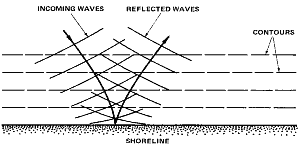 When
a beach is steep, the wave fronts get bent and then reflected back.
Sometimes part of the energy is absorbed and the remaining energy
reflected. When
a beach is steep, the wave fronts get bent and then reflected back.
Sometimes part of the energy is absorbed and the remaining energy
reflected. |
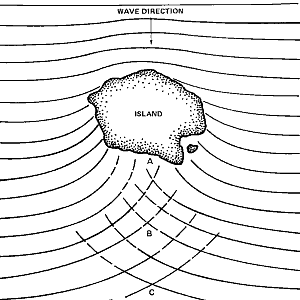 |
This drawing shows how waves are bent around an island
which should be at least 2-3 wave lengths wide in order to offer some
shelter. It causes immediately in the lee of the island (A) a wave
shadow zone but further out to sea a confusing sea (B) of interfering
but weakened waves which at some point (C) focuses the almost full wave
energy from two directions, resulting in unpredictable and dangerous
seas. When seeking shelter, avoid navigating through this area.
Recent research has shown that underwater sand banks
can act as wave lenses, refracting the waves and focussing them some
distance farther. It may suddenly accelerate coastal erosion in
localised places along the coast.
Drawings from Van Dorn, 1974.
|
 Tsunamis Tsunamis
At intervals of from 5-15 years, and often without prior warning, the
sea begins to heave and churn, sometimes receding to bare its floor, or
suddenly rising far beyond the normal range of wave and tide. Flooding
over breakwaters, tearing ships from their moorings, they leave wide
spread destruction to shoreline habitations and facilities. From the map
one can see that large tsunamis are rather rare. 13 of these were
recorded over a time span of 110 years! (Japanese: tsu, "harbour,"
and nami, "sea"). The map shows the origin of major
tsunamis in the Pacific Ocean from 1840 to 1960.
Tsunamis are caused by undersea earthquakes, seabed slides, or large
volcanic eruptions (Krakatoa 1883), and are therefore equally impossible
to predict. They are formed by a sudden uplift or subsidence of the sea
bottom, as if a large plunger was suddenly moved up or down. The way
they make themselves felt, varies considerably depending on the distance
travelled, their magnitude and the form of the coast. Tsunamis are large
waves travelling at high speed and limited by the narrow 4 km channel
between the sea's surface and the deep ocean floor.
|
Many of a tsunami's properties can be
understood with our knowledge of waves. In earlier subchapters on this page,
reference has been made to tsunamis:
- The amplitude of a tsunami depends on the size of the original
disturbance and distance travelled. A tsunami wave behaves much the same as
the widening circle radiating out from a pebble's plunge. As the circle
widens, the wave's crest lengthens and its height decreases proportionally
to the square root of distance travelled. After about 6700 nautical miles
(12,000 km) it reaches minimum amplitude, after which it starts focusing
again under the influence of coriolis forces and the curvature of Earth. At
sea a tsunami is hardly noticeable even though it travels so fast, typically
rising less than a metre over a period of 10-30 seconds. Such movement is
easily concealed by local waves.
- The speed of a tsunami wave is limited by the depth of the sea, to
about 450 knots (830 km/hr) in the Pacific Ocean.
- A tsunami of 4000m deep, bounces off the continental shelf,
producing a variety of wave forms. The continental shelf of 100m is a very
shallow area for these waves and they rise, form steep crests and very
large horizontal water movements, which over-run low lying areas, rip
boats from their moorings and may bare the sea to a depth of 5m or splash
against the coast to a height of 20-30m. The first tsunami wave is not
necessarily the worst.
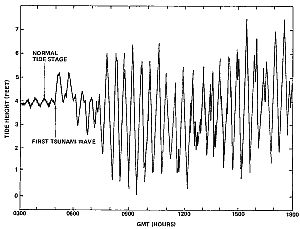 |
The picture shows a recording of the Chilean tsunami
wave of 22 May, 1960, as it was observed at Acapulco, Mexico, showing
vertically the tide height in feet and horizontally time in hours. The
first waves were less than half a metre high but three hours later many
oscillations of about 1.5m occurred. With some 20 crests in 10 hours,
the waves oscillated quite slowly but regularly. Perturbations of this
nature cause large coastal and harbour currents. Compared with a typical
tidal oscillation of 2m in 12.4 hours, the tsunami currents could have
been 15 times stronger than normal tidal currents.
The source of this earthquake in 1960 extended over a
distance of about 1,100 kilometres along the southern Chilean coast.
Casualties included about 5,700 killed and 3,000 injured, and property
damage amounted to many millions of dollars. Seismic sea waves excited
by the earthquake caused death and destruction in Hawaii, Japan, and the
Pacific coast of the United States.
|
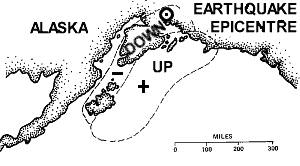 Dr
William Van Dorn (1974) gave the following account of the great
earthquake of 28 March 1964 on southeastern Alaska, and its tsunami: Dr
William Van Dorn (1974) gave the following account of the great
earthquake of 28 March 1964 on southeastern Alaska, and its tsunami:
The volume of water displaced defies imagination.
It involved a dislocation averaging 6 feet (1.8m) vertically over
100,000 square miles - thrice the size of Florida! About half this area
was on land, and subsided; the other half, which included the entire
100-mile wide shelf bordering the Gulf of Alaska, was bulged upward - in
some places as much as 50 feet (15m). The resulting mound of water
poured off the shelf for two hours, and fanned out over the Pacific,
creating widespread damage as far south as Crescent City, California,
1200 miles distant, where half of the business district was swept away.
Although this was by no means the most destructive
tsunami in historical times, five of Alaska's seven largest communities
were devastated by the combination of earthquake and wave damage. Its
fishing industry and most seaport facilities were virtually destroyed,
and only massive federal aid and years of effort have sufficed to
restore its crippled economy.
As a long-time student of tsunamis, I flew to
Alaska within 24 hours of the quake, and made a ten-day aerial tour of
the entire region affected, traveling by helicopter, navy aircraft and
chartered bush plane. Among accounts of calamities too numerous to
mention, is one of particular interest to mariners. Most of the Alaskan
crab fleet was at anchor in Kodiak harbour when they received belated
warning of "fifty-foot waves" passing Cape Chiniak, twenty
miles to the south. Getting rapidly underway, they were well out into
Chiniak Bay when they encountered the first incoming crest, estimated to
be thirty feet (9m) high and breaking. The next instant they were making
16 knots (30 km/hr) sternway, and were carried over a mile back into the
harbor, over a protective mole, and on up into the center of the
waterfront business district. The crab boats, being rather stoutly
constructed, were not appreciably damaged by this excursion into
unfamiliar territory, but a number of buildings were knocked down by
their gyrations.
The lesson here is that the fleet was within the
epicentral area of the earthquake, which was plainly felt by everyone.
The first waves arrived some 45 minutes later. Had the fleet put to sea
directly after the earthquake warning instead of waiting for further
advisement, the catastrophe might have been avoided.
|
 Some
of the damage wrought by the 1964 Alaskan tsunami. Photo
source US Geological Survey. Some
of the damage wrought by the 1964 Alaskan tsunami. Photo
source US Geological Survey. |
It is interesting but sad to note what
happened to the old town of Valdez, which was built on
unconsolidated and unstable deltaic sands and gravels. The shock
waves from the 1964 earthquake, running ahead of the tsunami,
caused the sediments under the waterfront area to spontaneously
liquefy, causing a large section of the delta to slump into Port
Valdez. Not only did this destroy the township, but it also
displaced a large volume of water, generating a local tsunami.
Since all of this occurred before the earthquake shaking ended,
the town had no warning at all, and all people on the town docks
at the time were killed by the tsunami. The combined effects of
the earthquake, and the 9-12m local tsunami destroyed most of
the waterfront and caused damage a considerable distance inland.
To make things worse, the forces caused the tanks at the Union
Oil Company to rupture, which started a fire that spread across
the entire waterfront, finishing off the few structures still
standing. |
|
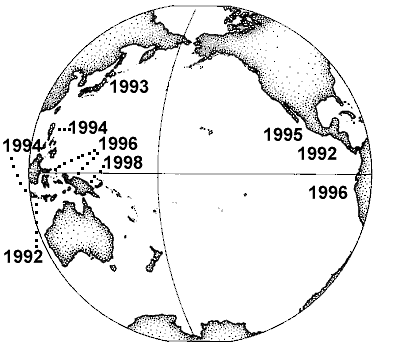 Earthquakes
and tsunamis could be monitored by sea-based monitoring stations. By
placing these along seismically active zones, they could warn
immediately after a potential earth quake occurred and when a tsunami
wave passes by. By placing sensors on the bottom of the sea, large waves
could be detected. Normal storm waves do not reach deep enough but a
tsunami's long wave would, even though its amplitude might be very
small. By means of satellite communication, the early warning signals
could be transmitted to a tsunami co-ordination centre, with direct
connections to coastal tsunami warning centres. Earthquakes
and tsunamis could be monitored by sea-based monitoring stations. By
placing these along seismically active zones, they could warn
immediately after a potential earth quake occurred and when a tsunami
wave passes by. By placing sensors on the bottom of the sea, large waves
could be detected. Normal storm waves do not reach deep enough but a
tsunami's long wave would, even though its amplitude might be very
small. By means of satellite communication, the early warning signals
could be transmitted to a tsunami co-ordination centre, with direct
connections to coastal tsunami warning centres.
The map shows all major earthquakes of the 1990s as
tabled below (Source: Scientific American, May 1999):
|
| Date |
Place |
Max wave |
Fatalities |
| 2 Sep 1992 |
Nicaragua |
10m |
170 |
| 12 Dec 1992 |
Flores Island |
26m |
>1000 |
| 12 July 1993 |
Okushiri, Japan |
31m |
239 |
| 2 June 1994 |
East Java |
14m |
238 |
| 14 Nov 1994 |
Mindoro Island |
7m |
49 |
| 9 Oct 1995 |
Jalisco, Mexico |
11m |
1 |
| 1 Jan 1996 |
Sulawesi Island |
3.4m |
9 |
| 17 Feb 1996 |
Irian Jaya |
7.7m |
161 |
| 21 Feb 1996 |
North coast of Peru |
5m |
12 |
| 17 July 1998 |
Papua New Guinea |
15m |
>2200 |
|
Also read Tsunami by Frank I Gonzalez. Scientific
American, May 1999. (Available from the Seafriends library)
Visit Dr
George Pararas-Carayannis pages on earthquakes and tsunamis.
Mega-tsunamis
Based on findings and projections of British geologist
Simon Day, the BBC television programme, in October 2000, screened a
disturbing documentary about the possibility of a mega tsunami arising
from a collapse of the Cumbre Vieja volcano on the island of La Palma in
the Canarias archipelago. The resulting shock wave could send a massive
wave all across the Atlantic Ocean, to swamp large areas of America's
east coast. Headlines in newspapers ran like this:
It was a scene straight from a disaster movie but a
disaster on such an epic scale that even the most flamboyant Hollywood
director would hesitate to suggest it might ever happen. Imagine being
transported in your tiny fishing boat on the crest of a wave 1,600ft
high - three times the height of Blackpool Tower- over forests and
glaciers and living to tell the tale. That is what happened to
fishermen Howard Ulrich and his son Sonny on a July evening in 1958 in
Lituya Bay, Alaska.
On 8 July 1958 a 7.5 magnitude (others say 8.3)
earthquake occurred along the Fairweather Fault, running along a trench
near Lituya Bay. As a result, a massive land slide originating from
1000m altitude, while possibly shifting 30 million m3 of earth, plunged
into the bay. The wave it caused, denuded the sides of the bay up to
516m high near the slide, and the rest of the shoreline between 200 and
30m high as it moved away towards the entrance. Simon Day extrapolated
that if the entire west flank of the Cumbre Vieja mountain did the same,
but with 1000 times more earth, it would send 650m shockwaves across the
ocean, that would still be 40-50m high when reaching the USA, 6500 km
away.
But computer models do not agree, and tsunami expert
Charles Mader advised that the wave would have a short wave length (less
than 10 minutes), rapidly decaying to a deep water wave before it
reached the US. |
The La Palma story helps us to brush
up our knowledge of the physics of waves (see above). Whether originating from
an underwater land slide, the explosion of a volcano or the impact of an
asteroid, waves still obey the same physical laws.
Impulse and energy: There are two aspects of a
disturbance that we need to distinguish: suddenness (velocity, v) and
volume (mass, m). The two combined create impulse or impact (v x m),
and kinetic energy (v x v x m). Impulse determines how much
matter will be moved by the disturbance (water and earth and buildings), which
is often more destructive than the energy content of the disturbance. Think for
instance of the huge energy contained in normal moon tides, which causes no harm
because tides move slowly.
Physical limitations: The critical element is how a
wave (a surface wave) moves through a narrow channel of 6000 km long but only
4km deep, the Atlantic Ocean. And there's an obstacle in the middle as well, the
Mid-atlantic Ridge. Such waves are physically limited to travel no faster than
700-800 km/h, giving them a wave period of around 2 minutes (120 sec) and a wave
length of 26 km (see equations above). This narrow channel soon dampens the
quicker components of a disturbance. Think for instance of a sudden movement,
like throwing a pebble into a pool. As the pebble displaces water outward, it
also produces a wave moving inward and upward, which dissipates most of the
energy and impact. So, as far as underwater tsunamis are concerned, the
long-distance component is proportional only to the amount of earth shifted (in
2 minutes). An underwater slip or slump consists of a volume of mud sliding down
hill. Since the velocity of such incidents is roughly the same, their impact
depends on mass only.
Impacts from outside, however, can produce larger waves.
Asteroids are a point in case. They travel at speeds between 10-70 km/s (usually
around 20 km/s=70,000 km/h), such that a 1km3 asteroid can produce a 70-90m deep
water wave 100 km away from impact, but such impacts occur about once in 100,000
years. (Please note that not all scientists agree on these figures)
Diminishing with distance travelled: Once the wave is
on its way, it fans out over 180 degrees, becoming weaker as it 'dilutes' over a
larger area, while encountering resistance as well. The wave weakens roughly
inversely to distance travelled, thus at 1000km distance, the wave is 100 times
(computers say 200 times) smaller (its energy 10,000 times less) than it was at
10km distance. The 1964 tsunami in Alaska shifted some 500 km3 of earth,
starting a deep water wave of 30m, which diminished to 0.3m at 1500 km distance,
then increased to 3-6m as it ran up the shallows. This wave caused substantial
damage to boats, piers and the business district in Crescent City, California.
The 1960 Chilean earthquake may have shifted over 1500 km3 (my estimate),
causing extensive coastal damage locally and as far away as Hawaii (15 hours)
and Japan (22 hours), but was hardly noticeable in New Zealand (18 hours later).
Mountain slide: According to Simon Day, in the case of
the Cumbre Vieja, as much as 500 billion tonnes (200 km3) of earth could
suddenly slide into the ocean, creating 650m waves locally. In his model he used
a solid wedge, which slid rapidly, but natural slumps break up and slide more
gradually. Since earth is between 2 and 3 times 'heavier' above water, land
slides can acquire 2-3 times more momentum from their mass, and another similar
amount from their higher speed, totalling perhaps 10 times. This would suggest
that the La Palma island mega tsunami would equate to an under water slump of no
more than 2000 km3.
Meteorites: Meteorite impact studies suggest that such
an impact (equal to 10,000 Mt TNT) equates to that of a 500m diameter asteroid
(0.037 km3). Such waves would diminish to less than one metre at 6000 km, but
would still be capable of causing much damage through their variable 'run-up'
effect.
Run-up: Tsunamis cause more or less damage depending
on how they run up the coast. As they enter shallow water, the waves rise and
slow down. Depending on the shape of the sea bottom and that of bays, their size
increases between two (normal) and forty times (very abnormal). A 1m wave could
thus rise to 2m (normal rise, within normal tidal range) or 40m, causing extreme
damage very locally.
Conclusion: although scientific knowledge and computer
models are not able to disproof Simon Days' findings, common sense
evaluation of the situation makes 40-50m tall waves swamping America and
Britain, highly unlikely.
Seiches and bores
Oscillations of lake water levels were first studied in Lake Geneva in
Switzerland, where they are called seiches. Seiches are standing
waves that slosh to and fro in deep lakes, from one end to another.
Changes in barometric pressure or other disturbances may start such
standing waves. The speed and length of standing waves is given by the
basin's depth and the distance between shores. In this manner each
enclosed body of water has its own standing wave characteristics.
At the entrances to semi-enclosed harbours, waves or an incoming tide
may start oscillations that bounce to and fro between the shores of the
harbour. Such oscillations can be started by large wave trains, gusty
winds and may damage moored boats.
When a spring tide comes in on a gently sloping shore which narrows
into a river entrance, the tide currents can become strong enough to
displace outflowing water and to rise up, forming a fast moving vertical
wall of water. Such a wave, characterised by a surge of water moving
swiftly upstream, headed by a wave or series of waves, is called a bore
(Old-Nordic bara=wave. A bore is also called an eagre).
A famous bore, known as the Mascaret on the French river Seine,
forms on spring tides and reaches some 50km inland. The bore can
reportedly outrun a horse (about 35km/hr). Other famous bores are found
in the Fu-chun River in china, the Amazon River in Brasil, the Severn in
England and the Petitcodiac River in New Brunswick, USA.
|
Internal waves
Internal waves are a class of gravity waves to be found almost entirely
under the surface. They propagate along the boundaries of layers of
water with differing densities:
- A thermocline forms when the sea heats up. Warm water being
lighter than cold water, remains on top. A temperature gradient
develops into a sharp thermocline. The water on top may be 4 degrees
warmer and 0.2% less dense.
- Fresh water flowing from large rivers, is lighter than salt
water and stays on top of it for many kilometres and several metres
depth. In fiords, the fresh water may form a 5m deep layer. The
fresh water is about 3.5% less dense.
|
Because of the small difference in density between such layers, the
corresponding restoring force for gravity waves is much less than that for
surface waves (which is the weight difference between water and air). From the
speed equation for gravity waves, it follows that internal waves move much more
slowly but at a fixed rate, which also depends on the depth of the boundary
layer. For instance, for a thermocline at 10m with a difference of 0.15%
density, the wave velocity would be 0.4m/s (1.4 km/hr). For a fresh water layer
of 5m depth, the wave velocity would be 1.3 m/s (6.1 km/hr).
Internal waves require very little energy to be set in motion. The tidal
current flowing over a sea bottom discontinuity could create packets of internal
waves. Internal wave amplitudes of tens of metres and periods of up to 12 hours
have been measured in the open ocean. Internal waves can also produce standing
waves (like seiches) in enclosed bays. Because these waves are difficult to
observe, very little is known about them.
The wave phase
velocity of gravity waves in a two layer ocean is given by:
c x c = g x d x (p2
- p1) / p2
where c = phase velocity, g =
acceleration of gravity (9.8), d = thickness of the upper layer
p1 = density of top layer, p2 = density
of deep layer.
From this formula it follows that the wave velocity of
internal waves depends both on the thickness of the layer and the
relative difference in density between the two layers.
It is interesting to note that the water particles above
the layer move clockwise whereas those below move counter clockwise. |
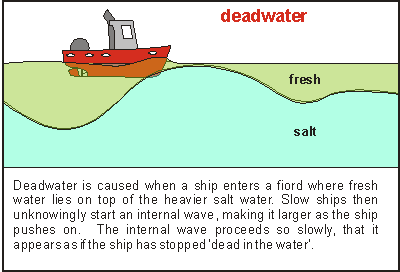 Although
they did not know what caused it, seamen were familiar with a strange
phenomenon, called deadwater. When travelling into a fiord, or
near an ice shelf, their slow ships seemed to come to a halt, and even
at full power they would only make very slow headway. Later, scientists
discovered its cause, an internal wave created by the ship's movement.
It appears as if the ship is travelling uphill against the heavier salt
water crest. A 1000 tonne ship could experience it as a 20 tonne drag,
because salt water of 3.5% is about 2% denser than fresh water. Although
they did not know what caused it, seamen were familiar with a strange
phenomenon, called deadwater. When travelling into a fiord, or
near an ice shelf, their slow ships seemed to come to a halt, and even
at full power they would only make very slow headway. Later, scientists
discovered its cause, an internal wave created by the ship's movement.
It appears as if the ship is travelling uphill against the heavier salt
water crest. A 1000 tonne ship could experience it as a 20 tonne drag,
because salt water of 3.5% is about 2% denser than fresh water. |
Internal waves arising from temperature or saline
differences, can reach magnitudes of 40m, bringing deep nutrient-rich
water right into the shallow light zone where it causes sudden and dense
plankton blooms.
The polar explorer Fridtjof Nansen, leader of the
Norwegian North Polar expedition to the Arctic in 1893-1896 reported the
following experience aboard the small research vessel Fram, as he was
tracking the ice dirft across the Arctic:
On tuesday, August 29th, 1893, the Fram got into open
water in the sound between the Isle of Taimur and the Almvist Islands
and steamed in calm water through the sound to the north-east. . . . We
approached the ice to make fast to it, but the Fram had got into
dead-water, and made hardly any way, in spite of the engine going at
full pressure. It was such slow work that I thought I would row ahead to
shoot seal. . . . the speed must have reduced to 1 - 1.5 knot in the
dead-water. . . The water at the surface was almost fresh, whereas
through the bottom-cock of the engine room we got perfectly salt water. |
In 1963, the nuclear submarine USS Thresher was lost
with all hands on board. Prior to the sinking there had been no
indication of equipment malfunction or unusual storm weather. While
submerged, submarines attain neutral buoyancy by flooding or jettisoning
seawater from a series of ballast tanks. An effective way for a
submarine to avoid detection by suface vessels is to dive and cruise
silently along density discontinuities (pycnoclines), which tend to
reflect the engine noise downward and sonar pulses from above upward.
Navy scientists speculate that the USS Thresher was probably cruising
along a pycnocline when it encountered a large internal wave. Because of
its neutral buoyancy, it is thought that the submarine suddenly slid
down the wave's back side, down to greater depths. Unable to compensate
for this sudden fall, the submarine exceeded its design depth and
imploded with loss of all life.
Source: Paul R Pinet: Oceanography.1992. |
How waves damage the rocky shore
 When
waves roll along in deep water, the water particles hardly move at all,
relative to each other. But once a wave enters shallow water, the
situation changes. At its foot, the wave meets a boundary that won't
move and as a consequence, the water particles move relative to that
boundary. At its top, the wave breaks, sending rushes of water forward.
At these two points, the bottom and the top, the coast appears under
severest attack of the waves. Depending on the amount of exposure and
depth, the rock face is ground to a shape of minimal erosion, such that
any point deviating from this shape, would erode faster than its
surroundings. Although affected by the vagaries of rock hardness and
homogenity, a typical coastal profile emerges. When
waves roll along in deep water, the water particles hardly move at all,
relative to each other. But once a wave enters shallow water, the
situation changes. At its foot, the wave meets a boundary that won't
move and as a consequence, the water particles move relative to that
boundary. At its top, the wave breaks, sending rushes of water forward.
At these two points, the bottom and the top, the coast appears under
severest attack of the waves. Depending on the amount of exposure and
depth, the rock face is ground to a shape of minimal erosion, such that
any point deviating from this shape, would erode faster than its
surroundings. Although affected by the vagaries of rock hardness and
homogenity, a typical coastal profile emerges.
In deep water, the profile plunges down vertically to over 20m depth.
These steep rock walls bounce waves back into sea, without absorbing
much of their energy at all. So erosion rates near the surface are low.
In moderately deep water, a drop-off may exist but the slope becomes
more gradual. Platforms are a consistent feature of the shore. In the
diagram with actual north-facing shore profiles, one can see a platform
developing in the sea urchin habitat, and perhaps also one lower down.
Because the urchins graze their patch thoroughly, the stoneleaf algae (Lithothamnia
sp) thrive, protecting the rock. What are the forces of the waves
that carve these shapes? |
 When
a mass of water is on the move, it is much harder to stop than air. Water is
about 800 times heavier than air. So it can turn and lift boulders. Enormous
pressure waves can develop when water is squeezed into a crack or cave. But most
damage is caused by the friction of water, as it races along a rock face
(shearing). Creatures attached to the rock may be ripped and their bodies washed
up on a beach. At the bottom, where the sand or pebbles can move freely, rocks
and organisms become sand-blasted and erosion here is high during large storms.
The freely moving sand may be deposited on deep rock flats, smothering the
attached organisms.
When
a mass of water is on the move, it is much harder to stop than air. Water is
about 800 times heavier than air. So it can turn and lift boulders. Enormous
pressure waves can develop when water is squeezed into a crack or cave. But most
damage is caused by the friction of water, as it races along a rock face
(shearing). Creatures attached to the rock may be ripped and their bodies washed
up on a beach. At the bottom, where the sand or pebbles can move freely, rocks
and organisms become sand-blasted and erosion here is high during large storms.
The freely moving sand may be deposited on deep rock flats, smothering the
attached organisms.
Ironically, scientists discovered that the hardness of the rock has little
bearing on its rate of wear [Taylor,
2000]. Such findings go against all logic, but nature can be
perplexing. What is often overlooked, is the protection afforded by organisms
living on the rock. Even a thin scum of algae prevents water and sand from
touching its surface, and although the living skin may suffer damage, it is
capable of repairing itself. The 'living skin' idea could explain why soft rock
is protected relatively better (because it is easier to attach to), than hard
rock such as granite (is too smooth for attachment). It could explain the
existence of platforms (because these are the best form for sun-loving plants)
and why the shoreline erodes so slowly despite the enormous forces occurring in
the wave zone. It could also explain why shaded coasts wear faster (because the
protective film grows slower), and why coastal erosion is increasing everywhere
in the world (because protective organisms are disappearingdue to pollution and
mud).
Among the rock-protecting creatures one can find both animals (that don't
need sunlight) and plants (that do need sunlight). Animals: barnacles, flea
mussels, greenlipped mussels. Plants: various matting algae, pink paint (Lithothamnia
sp), large algae.
Amongst the living skin, also creatures can be found that are capable of
drilling into soft rock. They do so by means of scraping, assisted by excreting
acids. Particularly limestone-rich rocks can be attacked in this way.
Reader please note that the above are my own observations
that have not been confirmed by scientific method. Floor Anthoni
Taylor, Anna.
Geography Dept, Univ Canterbury: Erosion of shore platforms, East Coast,
South Island, New Zealand. International Coastal Symposium 2000, Rotorua,
New Zealand.
 These
live paua shells (abalone Haliotis iris), living close to the
bottom of a shallow cave in northern New Zealand, have been abraded by
shingle, showing their finely polished nacre. It was like entering
Aladdin's cave of treasures. The rocks were finely polished too. These
live paua shells (abalone Haliotis iris), living close to the
bottom of a shallow cave in northern New Zealand, have been abraded by
shingle, showing their finely polished nacre. It was like entering
Aladdin's cave of treasures. The rocks were finely polished too.
By night, pauas leave their sleeping places to browse
the rocks that are exposed to sunlight by day. |
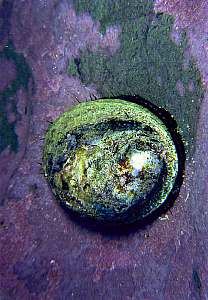 Close-up
of a polished paua shell. Notice that the rock is covered by a rock-hard
pink alga, affectionately called 'pink paint' (Lithothamnia sp.).
It is apparently hardy and resilient enough to repair damage from both
the grazing of paua and abrasion from shingle. This most amazing rock
lining lives from shallow rock pools, down to 50m depth. Here it thrives
in the darkness of this cave. Close-up
of a polished paua shell. Notice that the rock is covered by a rock-hard
pink alga, affectionately called 'pink paint' (Lithothamnia sp.).
It is apparently hardy and resilient enough to repair damage from both
the grazing of paua and abrasion from shingle. This most amazing rock
lining lives from shallow rock pools, down to 50m depth. Here it thrives
in the darkness of this cave. |
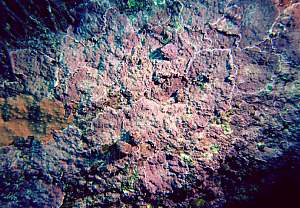 Close-up
of pink paint (Lithothamnia sp) on the side of a rock at 20m
depth. The edges of each plant (leaf) can clearly be distinguished. Top
left, part of a kelp's holdfast (Ecklonia radiata) is seen. A
number of top shells can be distinguished, grazing the pink paint. Close-up
of pink paint (Lithothamnia sp) on the side of a rock at 20m
depth. The edges of each plant (leaf) can clearly be distinguished. Top
left, part of a kelp's holdfast (Ecklonia radiata) is seen. A
number of top shells can be distinguished, grazing the pink paint. |
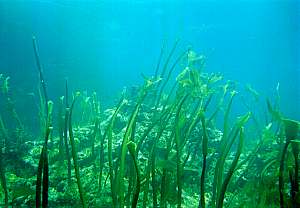 These
young kelp plants had settled in shallow water (6m), the domain of the
sea urchins. During a storm (cyclone Fergus), their canopies were
stripped off, causing almost full mortality. It is amazing to see how
sharp the boundaries of storm damage are. Only one metre deeper, none of
the kelp plants was affected. These
young kelp plants had settled in shallow water (6m), the domain of the
sea urchins. During a storm (cyclone Fergus), their canopies were
stripped off, causing almost full mortality. It is amazing to see how
sharp the boundaries of storm damage are. Only one metre deeper, none of
the kelp plants was affected. |
 In
the diagram some familiar terms are shown. A floating object is observed to move
in perfect circles when waves oscillate harmoniously sinus-like. If that object
hovered in the water, like a water particle, it would be moving along
diminishing circles, when placed deeper in the water. At a certain depth, the
object would stand still. This is the wave's base, precisely half the wave's
length. Thus long waves (ocean swell) extend much deeper down than short waves
(chop). Waves with 100 metres between crests are common and could stir the
bottom down to a depth of 50m. Note that the depth of a wave has little to do
with its height! But a wave's height contains the wave's energy, which is
unrelated to the wave's length. Long surface waves travel faster and further
than short ones.
In
the diagram some familiar terms are shown. A floating object is observed to move
in perfect circles when waves oscillate harmoniously sinus-like. If that object
hovered in the water, like a water particle, it would be moving along
diminishing circles, when placed deeper in the water. At a certain depth, the
object would stand still. This is the wave's base, precisely half the wave's
length. Thus long waves (ocean swell) extend much deeper down than short waves
(chop). Waves with 100 metres between crests are common and could stir the
bottom down to a depth of 50m. Note that the depth of a wave has little to do
with its height! But a wave's height contains the wave's energy, which is
unrelated to the wave's length. Long surface waves travel faster and further
than short ones.
 These
two diagrams show the relationships between wave speed and period for
various depths (left), and wave length and period (right), for periodic,
progressive surface waves. (Adapted from Van Dorn, 1974)
Note that the term phase velocity is more precise than wave
speed.
These
two diagrams show the relationships between wave speed and period for
various depths (left), and wave length and period (right), for periodic,
progressive surface waves. (Adapted from Van Dorn, 1974)
Note that the term phase velocity is more precise than wave
speed.
 How
wind causes water to form waves is easy to understand although many
intricate details still lack a satisfactory theory. On a perfectly calm
sea, the wind has practically no grip. As it slides over the water
surface film, it makes it move. As the water moves, it forms eddies and
small ripples. Ironically, these ripples do not travel exactly in the
direction of the wind but as two sets of parallel ripples, at angles
70-80º to the wind direction. The ripples make the water's surface
rough, giving the wind a better grip. The ripples, starting at a minimum
wave speed of 0.23 m/s, grow to wavelets and start to travel in the
direction of the wind. At wind speeds of 4-6 knots (7-11 km/hr), these
double wave fronts travel at about 30º from the wind. The surface still
looks glassy overall but as the wind speed increases, the wavelets
become high enough to interact with the air flow and the surface starts
to look rough. The wind becomes turbulent just above the surface and
starts transferring energy to the waves. Strong winds are more turbulent
and make waves more easily.
How
wind causes water to form waves is easy to understand although many
intricate details still lack a satisfactory theory. On a perfectly calm
sea, the wind has practically no grip. As it slides over the water
surface film, it makes it move. As the water moves, it forms eddies and
small ripples. Ironically, these ripples do not travel exactly in the
direction of the wind but as two sets of parallel ripples, at angles
70-80º to the wind direction. The ripples make the water's surface
rough, giving the wind a better grip. The ripples, starting at a minimum
wave speed of 0.23 m/s, grow to wavelets and start to travel in the
direction of the wind. At wind speeds of 4-6 knots (7-11 km/hr), these
double wave fronts travel at about 30º from the wind. The surface still
looks glassy overall but as the wind speed increases, the wavelets
become high enough to interact with the air flow and the surface starts
to look rough. The wind becomes turbulent just above the surface and
starts transferring energy to the waves. Strong winds are more turbulent
and make waves more easily. When
trying to be more precise about waves, difficulties arise: how do we
measure waves objectively? When is a wave a wave and should be counted?
Scientists do this by introducing a value E which is derived from
the energy component of the compound wave. In the left part of the
drawing is shown how the value E is derived entirely
mathematically from the shape of the wave. Instruments can also measure
it precisely and objectively. The wave height is now proportional to the
square root of E.
When
trying to be more precise about waves, difficulties arise: how do we
measure waves objectively? When is a wave a wave and should be counted?
Scientists do this by introducing a value E which is derived from
the energy component of the compound wave. In the left part of the
drawing is shown how the value E is derived entirely
mathematically from the shape of the wave. Instruments can also measure
it precisely and objectively. The wave height is now proportional to the
square root of E.
 When
the wind blows sufficiently long from the same direction, the waves it
creates, reach maximum size, speed and period beyond a certain distance
(fetch) from the shore. This is called a fully developed sea.
Because the waves travel at speeds close to that of the wind, the wind
is no longer able to transfer energy to them and the sea state has
reached its maximum. In the picture the wave spectra of three different
fully developed seas are shown. The bell curve for a 20 knot wind
(green) is flat and low and has many high frequency components (wave
periods 1-10 seconds). As the wind speed increases, the wave spectrum
grows rapidly while also expanding to the low frequencies (to the
right). Note how the bell curve rapidly cuts off for long wave periods,
to the right. Compare the size of the red bell, produced by 40 knot
winds, with that of the green bell, produced by winds of half that
speed. The energy in the red bell is 16 times larger!
When
the wind blows sufficiently long from the same direction, the waves it
creates, reach maximum size, speed and period beyond a certain distance
(fetch) from the shore. This is called a fully developed sea.
Because the waves travel at speeds close to that of the wind, the wind
is no longer able to transfer energy to them and the sea state has
reached its maximum. In the picture the wave spectra of three different
fully developed seas are shown. The bell curve for a 20 knot wind
(green) is flat and low and has many high frequency components (wave
periods 1-10 seconds). As the wind speed increases, the wave spectrum
grows rapidly while also expanding to the low frequencies (to the
right). Note how the bell curve rapidly cuts off for long wave periods,
to the right. Compare the size of the red bell, produced by 40 knot
winds, with that of the green bell, produced by winds of half that
speed. The energy in the red bell is 16 times larger! The
biggest waves on the planet are found where strong winds consistently
blow in a constant direction. Such a place is found south of the Indian
Ocean, at latitudes of -40º to -60º, as shown by the yellow and red
colours on this satellite map. Waves here average 7m, with the
occasional waves twice that height! Directly south of New Zealand, wave
heights exceeding 5m are also normal. The lowest waves occur where wind
speeds are lowest, around the equator, particularly where the wind's
fetch is limited by islands, indicated by the pink colour on this map.
However, in these places, the sea water warms up, causing the birth of
tropical cyclones, typhoons or hurricanes, which may send large waves in
all directions, particularly in the direction they are travelling.
The
biggest waves on the planet are found where strong winds consistently
blow in a constant direction. Such a place is found south of the Indian
Ocean, at latitudes of -40º to -60º, as shown by the yellow and red
colours on this satellite map. Waves here average 7m, with the
occasional waves twice that height! Directly south of New Zealand, wave
heights exceeding 5m are also normal. The lowest waves occur where wind
speeds are lowest, around the equator, particularly where the wind's
fetch is limited by islands, indicated by the pink colour on this map.
However, in these places, the sea water warms up, causing the birth of
tropical cyclones, typhoons or hurricanes, which may send large waves in
all directions, particularly in the direction they are travelling. As
waves enter shallow water, they slow down, grow taller and change shape.
At a depth of half its wave length, the rounded waves start to rise and
their crests become shorter while their troughs lengthen. Although their
period (frequency) stays the same, the waves slow down and their overall
wave length shortens. The 'bumps' gradually steepen and finally break in
the surf when depth becomes less than 1.3 times their height. Note that
waves change shape in depths depending on their wave length, but
break in shallows relating to their height!
As
waves enter shallow water, they slow down, grow taller and change shape.
At a depth of half its wave length, the rounded waves start to rise and
their crests become shorter while their troughs lengthen. Although their
period (frequency) stays the same, the waves slow down and their overall
wave length shortens. The 'bumps' gradually steepen and finally break in
the surf when depth becomes less than 1.3 times their height. Note that
waves change shape in depths depending on their wave length, but
break in shallows relating to their height!




 Wave
groups
Wave
groups When
wave fronts approach a gently sloping beach on an angle, they slow down
in the shallows, causing them to bend towards the beach. If the beach
slopes gently enough, all breakers will eventually line up parallel to
the beach.
When
wave fronts approach a gently sloping beach on an angle, they slow down
in the shallows, causing them to bend towards the beach. If the beach
slopes gently enough, all breakers will eventually line up parallel to
the beach. When
a beach is steep, the wave fronts get bent and then reflected back.
Sometimes part of the energy is absorbed and the remaining energy
reflected.
When
a beach is steep, the wave fronts get bent and then reflected back.
Sometimes part of the energy is absorbed and the remaining energy
reflected.
 Tsunamis
Tsunamis
 Dr
William Van Dorn (1974) gave the following account of the great
earthquake of 28 March 1964 on southeastern Alaska, and its tsunami:
Dr
William Van Dorn (1974) gave the following account of the great
earthquake of 28 March 1964 on southeastern Alaska, and its tsunami:
 Some
of the damage wrought by the 1964 Alaskan tsunami. Photo
source US Geological Survey.
Some
of the damage wrought by the 1964 Alaskan tsunami. Photo
source US Geological Survey. Earthquakes
and tsunamis could be monitored by sea-based monitoring stations. By
placing these along seismically active zones, they could warn
immediately after a potential earth quake occurred and when a tsunami
wave passes by. By placing sensors on the bottom of the sea, large waves
could be detected. Normal storm waves do not reach deep enough but a
tsunami's long wave would, even though its amplitude might be very
small. By means of satellite communication, the early warning signals
could be transmitted to a tsunami co-ordination centre, with direct
connections to coastal tsunami warning centres.
Earthquakes
and tsunamis could be monitored by sea-based monitoring stations. By
placing these along seismically active zones, they could warn
immediately after a potential earth quake occurred and when a tsunami
wave passes by. By placing sensors on the bottom of the sea, large waves
could be detected. Normal storm waves do not reach deep enough but a
tsunami's long wave would, even though its amplitude might be very
small. By means of satellite communication, the early warning signals
could be transmitted to a tsunami co-ordination centre, with direct
connections to coastal tsunami warning centres.
 Although
they did not know what caused it, seamen were familiar with a strange
phenomenon, called deadwater. When travelling into a fiord, or
near an ice shelf, their slow ships seemed to come to a halt, and even
at full power they would only make very slow headway. Later, scientists
discovered its cause, an internal wave created by the ship's movement.
It appears as if the ship is travelling uphill against the heavier salt
water crest. A 1000 tonne ship could experience it as a 20 tonne drag,
because salt water of 3.5% is about 2% denser than fresh water.
Although
they did not know what caused it, seamen were familiar with a strange
phenomenon, called deadwater. When travelling into a fiord, or
near an ice shelf, their slow ships seemed to come to a halt, and even
at full power they would only make very slow headway. Later, scientists
discovered its cause, an internal wave created by the ship's movement.
It appears as if the ship is travelling uphill against the heavier salt
water crest. A 1000 tonne ship could experience it as a 20 tonne drag,
because salt water of 3.5% is about 2% denser than fresh water.  When
waves roll along in deep water, the water particles hardly move at all,
relative to each other. But once a wave enters shallow water, the
situation changes. At its foot, the wave meets a boundary that won't
move and as a consequence, the water particles move relative to that
boundary. At its top, the wave breaks, sending rushes of water forward.
At these two points, the bottom and the top, the coast appears under
severest attack of the waves. Depending on the amount of exposure and
depth, the rock face is ground to a shape of minimal erosion, such that
any point deviating from this shape, would erode faster than its
surroundings. Although affected by the vagaries of rock hardness and
homogenity, a typical coastal profile emerges.
When
waves roll along in deep water, the water particles hardly move at all,
relative to each other. But once a wave enters shallow water, the
situation changes. At its foot, the wave meets a boundary that won't
move and as a consequence, the water particles move relative to that
boundary. At its top, the wave breaks, sending rushes of water forward.
At these two points, the bottom and the top, the coast appears under
severest attack of the waves. Depending on the amount of exposure and
depth, the rock face is ground to a shape of minimal erosion, such that
any point deviating from this shape, would erode faster than its
surroundings. Although affected by the vagaries of rock hardness and
homogenity, a typical coastal profile emerges.  When
a mass of water is on the move, it is much harder to stop than air. Water is
about 800 times heavier than air. So it can turn and lift boulders. Enormous
pressure waves can develop when water is squeezed into a crack or cave. But most
damage is caused by the friction of water, as it races along a rock face
(shearing). Creatures attached to the rock may be ripped and their bodies washed
up on a beach. At the bottom, where the sand or pebbles can move freely, rocks
and organisms become sand-blasted and erosion here is high during large storms.
The freely moving sand may be deposited on deep rock flats, smothering the
attached organisms.
When
a mass of water is on the move, it is much harder to stop than air. Water is
about 800 times heavier than air. So it can turn and lift boulders. Enormous
pressure waves can develop when water is squeezed into a crack or cave. But most
damage is caused by the friction of water, as it races along a rock face
(shearing). Creatures attached to the rock may be ripped and their bodies washed
up on a beach. At the bottom, where the sand or pebbles can move freely, rocks
and organisms become sand-blasted and erosion here is high during large storms.
The freely moving sand may be deposited on deep rock flats, smothering the
attached organisms.
 These
live paua shells (abalone Haliotis iris), living close to the
bottom of a shallow cave in northern New Zealand, have been abraded by
shingle, showing their finely polished nacre. It was like entering
Aladdin's cave of treasures. The rocks were finely polished too.
These
live paua shells (abalone Haliotis iris), living close to the
bottom of a shallow cave in northern New Zealand, have been abraded by
shingle, showing their finely polished nacre. It was like entering
Aladdin's cave of treasures. The rocks were finely polished too. Close-up
of a polished paua shell. Notice that the rock is covered by a rock-hard
pink alga, affectionately called 'pink paint' (Lithothamnia sp.).
It is apparently hardy and resilient enough to repair damage from both
the grazing of paua and abrasion from shingle. This most amazing rock
lining lives from shallow rock pools, down to 50m depth. Here it thrives
in the darkness of this cave.
Close-up
of a polished paua shell. Notice that the rock is covered by a rock-hard
pink alga, affectionately called 'pink paint' (Lithothamnia sp.).
It is apparently hardy and resilient enough to repair damage from both
the grazing of paua and abrasion from shingle. This most amazing rock
lining lives from shallow rock pools, down to 50m depth. Here it thrives
in the darkness of this cave. Close-up
of pink paint (Lithothamnia sp) on the side of a rock at 20m
depth. The edges of each plant (leaf) can clearly be distinguished. Top
left, part of a kelp's holdfast (Ecklonia radiata) is seen. A
number of top shells can be distinguished, grazing the pink paint.
Close-up
of pink paint (Lithothamnia sp) on the side of a rock at 20m
depth. The edges of each plant (leaf) can clearly be distinguished. Top
left, part of a kelp's holdfast (Ecklonia radiata) is seen. A
number of top shells can be distinguished, grazing the pink paint. These
young kelp plants had settled in shallow water (6m), the domain of the
sea urchins. During a storm (cyclone Fergus), their canopies were
stripped off, causing almost full mortality. It is amazing to see how
sharp the boundaries of storm damage are. Only one metre deeper, none of
the kelp plants was affected.
These
young kelp plants had settled in shallow water (6m), the domain of the
sea urchins. During a storm (cyclone Fergus), their canopies were
stripped off, causing almost full mortality. It is amazing to see how
sharp the boundaries of storm damage are. Only one metre deeper, none of
the kelp plants was affected.